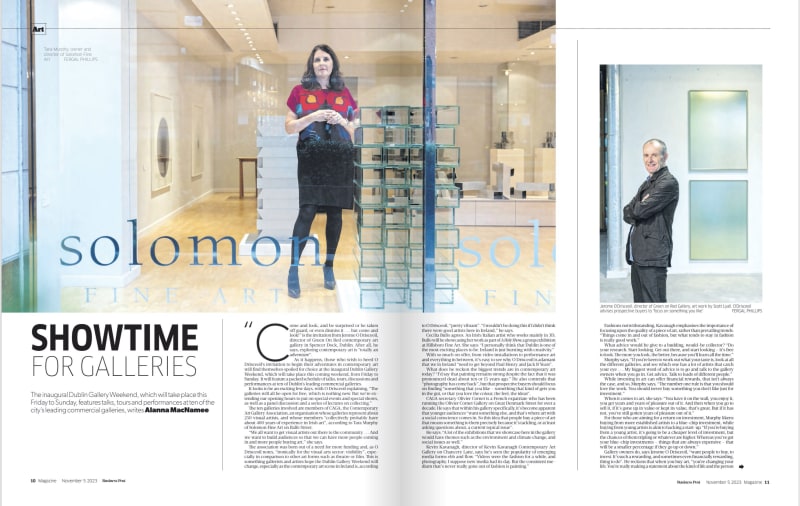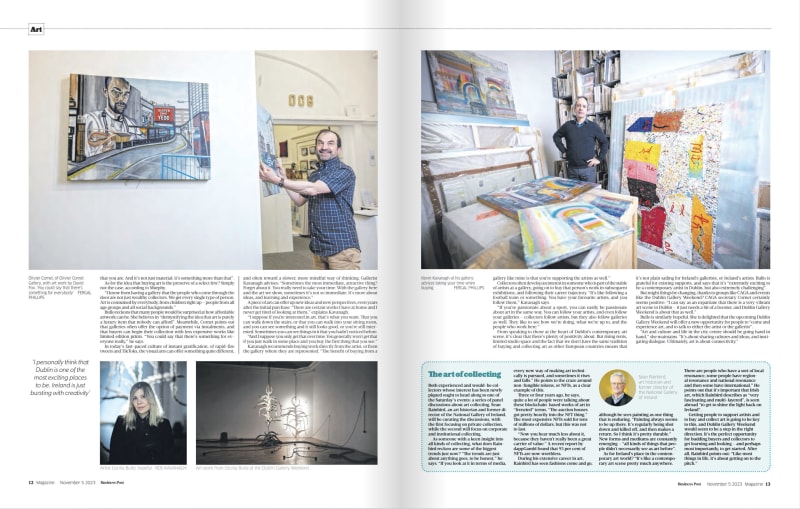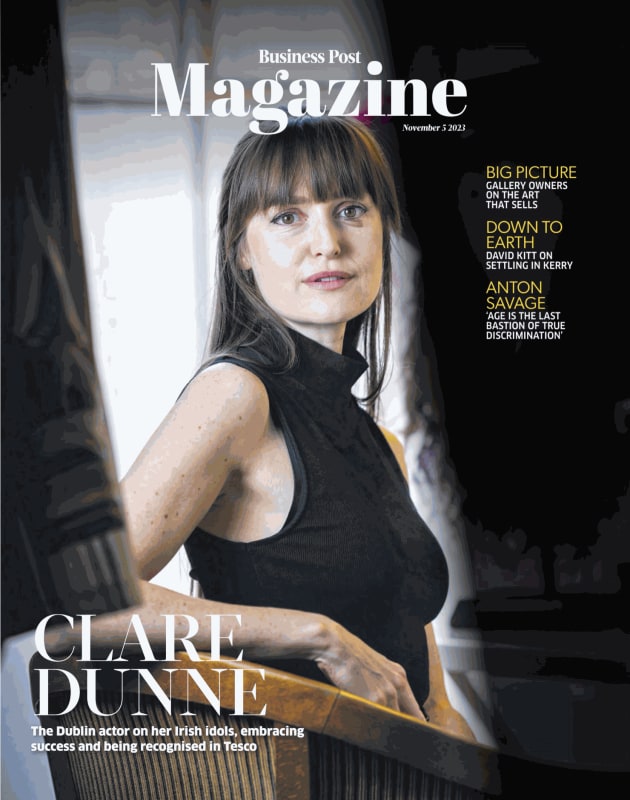“Come and look, and be surprised or be taken off guard, or even dismiss it . . . but come and look!” is the invitation from Jerome O Drisceoil, director of Green On Red contemporary art gallery in Spencer Dock, Dublin. After all, he says, exploring contemporary art is “totally an adventure”.
As it happens, those who wish to heed O Drisceoil’s invitation to begin their adventures in contemporary art will find themselves spoiled for choice at the inaugural Dublin Gallery Weekend, which will take place from November 10-12. It will feature a packed schedule of talks, tours, discussions and performances at ten of Dublin’s leading commercial galleries.
It looks to be an exciting few days, with O Drisceoil explaining, “The galleries will all be open for free, which is nothing new. But we’re extending our opening hours to put on special events and special shows, as well as a panel discussion and a series of lectures on collecting.”
The ten galleries involved are members of CAGA, the Contemporary Art Gallery Association, an organisation whose galleries represent about 250 visual artists, and whose members “collectively probably have about 400 years of experience in Irish art”, according to Tara Murphy of Solomon Fine Art on Balfe Street.
“We all want to get visual artists out there to the community . . . And we want to build audiences so that we can have more people coming in and more people buying art,” she says.
The association was born out of a need for more funding and, as O Drisceoil notes, “ironically for the visual arts sector: visibility”, especially in comparison to other art forms such as theatre or film. This is something gallerists and artists hope the Dublin Gallery Weekend will change, especially as the contemporary art scene in Ireland is, according to O Drisceoil, “pretty vibrant”. “I wouldn’t be doing this if I didn’t think there were good artists here in Ireland,” he says.
Cecilia Bullo agrees. An Irish/Italian artist who works mainly in 3D, Bullo will be showcasing her work at the Gallery Weekend as part of A Holy Show, a group exhibition which will be held at Hillsboro Fine Art. She says, “I personally think that Dublin is one of the most exciting places to be. Ireland is just bursting with creativity.”
With so much on offer, from video installations to performance art and everything in between, it’s easy to see why O Drisceoil is adamant that we in Ireland “need to get beyond Paul Henry and Jack B Yeats”.
What does he reckon the biggest trends are in contemporary art today? “I’d say that painting remains strong despite the fact that it was pronounced dead about ten or 15 years ago.” He also contends that “photography has come back”, but that prospective buyers should focus on finding “something that you like – something that kind of gets you in the gut, or that you love the colour, the feel, the ideas”.
CAGA secretary Olivier Cornet is a French expatriate who has been running the Olivier Cornet Gallery on Great Denmark Street for over a decade. He says that within his gallery specifically, it’s become apparent that younger audiences “want something else, and that’s where art with a social conscience comes in. So this idea that people buy a piece of art that means something to them precisely because it’s tackling, or at least asking questions about, a current topical issue”.
He explains, “A lot of the exhibitions that we showcase here in the gallery would have themes such as the environment and climate change, and social issues as well.”
Kevin Kavanagh, director of Kevin Kavanagh Contemporary Art Gallery on Chancery Lane, says he’s seen the popularity of emerging media forms ebb and flow. “Videos were the fashion for a while, and photography. I suppose new media had its day. But the consistent medium that’s never really gone out of fashion is painting.”
Fashions notwithstanding, Kavanagh emphasises the importance of focusing upon the quality of a piece of art, rather than prevailing trends. “Things come in and out of fashion, but what tends to stay in fashion is really good work.”
What advice would he give to a budding, would-be collector? “Do your research. Start looking. Get out there, and start looking – it’s free to look. The more you look, the better, because you’ll learn all the time.”
Murphy advises, “If you’re keen to work out what your taste is, look at all the different galleries, and see which one has a lot of artists that catch your eye . . . My biggest word of advice is to go and talk to the gallery owners when you go in. Get advice. Talk to loads of different people.”
While investing in art can offer financial rewards, that isn’t always the case, and so, Murphy says, “The number one rule is that you should love the work. You should never buy something you don’t like just for investment.”
When it comes to art, she says, “You have it on the wall, you enjoy it, you get years and years of pleasure out of it. And then when you go to sell it, if it’s gone up in value or kept its value, that’s great. But if it has not, you’ve still gotten years of pleasure out of it.”
For those who are aiming for a return on investment, Murphy likens buying from more established artists to a blue-chip investment, while buying from young artists is akin to backing a start-up. “If you’re buying from a young artist, it’s going to be a cheaper level of investment, but the chances of them tripling or whatever are higher. Whereas you’ve got your blue-chip investments – things that are always expensive – that will be a smaller percentage if they go up or down.”
Gallery owners do, says Jerome O Drisceoil, “want people to buy, to invest. It’s such a rewarding, and sometimes even financially rewarding, thing to do”. He reckons that when you buy art, “you’re changing your life. You’re really making a statement about the kind of life and the person that you are. And it’s not just material: it’s something more than that”.
As for the idea that buying art is the preserve of a select few? Simply not the case, according to Murphy. “I know from having a gallery that the people who come through the door are not just wealthy collectors. We get every single type of person. Art is consumed by everybody, from children right up – people from all age groups and all social backgrounds.”
Bullo reckons that many people would be surprised at how affordable artwork can be. She believes in “demystifying the idea that art is purely a luxury item that nobody can afford”. Meanwhile, Cornet points out that galleries often offer the option of payment via instalments, and that buyers can begin their collection with less expensive works like limited edition prints. “You could say that there’s something for everyone really,” he says.
In today’s fast-paced culture of instant gratification, of rapid-fire tweets and TikToks, the visual arts can offer something quite different, and often reward a slower, more mindful way of thinking. Gallerist Kavanagh advises: “Sometimes the most immediate, attractive thing? Forget about it. You really need to take your time. With the gallery here and the art we show, sometimes it’s not so immediate. It’s more about ideas, and learning and experience.”
A piece of art can offer up new ideas and new perspectives, even years after the initial purchase. “There are certain works I have at home and I never get tired of looking at them,” explains Kavanagh.
“I suppose if you’re interested in art, that’s what you want. That you can walk down the stairs, or that you can walk into your sitting room, and you can see something and it still looks good, or you’re still interested. Sometimes you can see things in it that you hadn’t noticed before.
“And I suppose you only get that over time. You generally won’t get that if you just walk in some place and you buy the first thing that you see.”
Kavanagh recommends buying work directly from the artist, or from the gallery where they are represented. “The benefit of buying from a gallery like mine is that you’re supporting the artists as well.”
Collectors often develop an interest in someone who is part of the stable of artists at a gallery, going on to buy that person’s work in subsequent exhibitions, and following their career trajectory. “It’s like following a football team or something. You have your favourite artists, and you follow them,” Kavanagh says.
“If you’re passionate about a sport, you can easily be passionate about art in the same way. You can follow your artists, and even follow your galleries – collectors follow artists, but they also follow galleries as well. They like to see how we’re doing, what we’re up to, and the people who work here.”
From speaking to those at the heart of Dublin’s contemporary art scene, it’s clear that there’s plenty of positivity about. But rising rents, limited studio space and the fact that we don’t have the same tradition of buying and collecting art as other European countries means that it’s not plain sailing for Ireland’s gallerists, or Ireland’s artists. Bullo is grateful for existing supports, and says that it’s “extremely exciting to be a contemporary artist in Dublin, but also extremely challenging”.
But might things be changing, thanks to groups like CAGA and events like the Dublin Gallery Weekend? CAGA secretary Cornet certainly seems positive: “I can say as an expatriate that there is a very vibrant art scene in Dublin – it just needs a bit of a booster, and Dublin Gallery Weekend is about that as well.”
Bullo is similarly hopeful. She is delighted that the upcoming Dublin Gallery Weekend will offer a new opportunity for people to “come and experience art, and to talk to either the artist or the gallerist”.
“Art and culture and life in the city centre should be going hand in hand,” she maintains. “It’s about sharing cultures and ideas, and instigating dialogue. Ultimately, art is about connectivity.”



